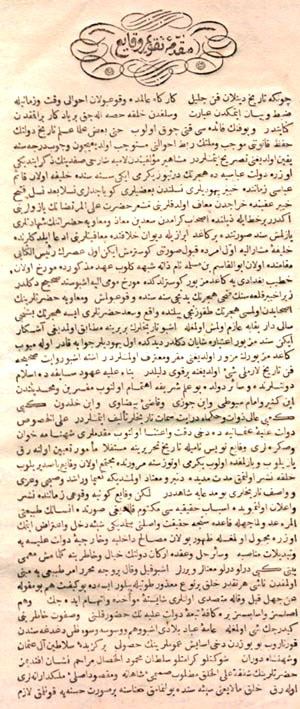 | ||
The history of Middle Eastern newspapers goes back to the 19th century. Many editors were not only journalists but also writers, philosophers and politicians. With unofficial journals, these intellectuals encouraged public discourse on politics in the Ottoman and Persian Empires. Literary works of all genres were serialized and published in the press as well.
Contents
European influences
The first newspapers in the Ottoman Empire were owned by foreigners living there who wanted to make propaganda about the Western world. The earliest was printed in September 1795 by the Palais de France in Pera, during the embassy of Raymond de Verninac-Saint-Maur. It was issued fortnightly under the title "Bulletin de Nouvelles", until March 1796, it seems. Afterwards, it was published under the name "Gazette française de Constantinople" from September 1796 to May 1797, and "Mercure Oriental" from May to July 1797. Its main purpose was to convey information about the politics of Post-Revolutionary France to foreigners living in Istanbul; therefore, it had little impact on local population.
In 1800, during the French occupation of Egypt, a newspaper in Arabic, al-Tanbih (The Alert), was planned to be issued, with the purpose of disseminating in Egypt the ideals of the French Revolution. It was founded by the general Jacques-François Menou, who appointed Ismail al-Khashab as its editor. However, there is doubt the newspaper was actually ever printed. Menou eventually capitulated after Alexandria was besieged by British forces in 1801.
The history of indigenous Middle Eastern journalism starts in 1828, when Muhammad Ali, Khedive of Egypt, ordered the local establishment of the gazette Vekayi-i Misriye (Egyptian Affairs), as part of the drastic reforms he was implementing in the province. It was first written in Ottoman Turkish and Arabic on opposite pages, and later in Arabic only, under the title "al-Waqa'i`a al-Masriya".
The first official gazette of the Ottoman State was published in 1831, on the order of Mahmud II. It was entitled "Moniteur Ottoman", perhaps referring to the French newspaper Le Moniteur Universel. Its weekly issues were written in French and edited by Alexandre Blacque at the expense of the Porte. A few months later, a firman of the sultan ordered that the gazette be written in Turkish and renamed "Takvim-i Vekayi" (Calendar of Affairs). It was issued irregularly until November 4, 1922. Laws and decrees of the sultan were published in it, as well as descriptions of court festivities.
The first non-official Turkish newspaper, Ceride-i Havadis (Register of Events), was published by an Englishman, William Churchill, in 1840. The first private newspaper to be published by Turkish journalists, Tercüman-ı Ahvâl (Interpreter of Events), was founded by İbrahim Şinasi and Agah Efendi and issued in October 1860; the owners stated that "freedom of expression is a part of human nature", thereby initiating an era of free press as inspired by the ideals of 18th century French Enlightenment. In the meantime, the first private newspaper written solely in Arabic, Mir'at al-ahwal, had been founded by a Syrian poet, Rizqallah Hassun, in 1855, but it had been suspended a year later by Ottoman authorities because of its critical tone regarding their policies. Subsequently, several newspapers flourished in the provinces. A new press code inspired by French law, Matbuat Nizamnamesi, was issued in 1864, accompanied by the establishment of a censorship office.
Women
One of the earliest women to sign her articles in the Arab press was the female medical practitioner Galila Tamarhan, who contributed articles to a medical magazine called "Ya`asub al-Tib" (Leader in Medicine) in the 1860s. The Syrian writer and poet Maryana Marrash seems to have been the first woman to write in the Arab daily newspapers. In 1892, the Lebanese journalist Hind Nawfal published the first monthly journal for women, Al Fatat (The Young Girl), in Alexandria, Egypt.
Iran
The first newspaper in Iran, Kaghaz-e Akhbar (The Newspaper), was created for the government by Mirza Saleh Shirazi in 1837. Shirazi had been sent to study in England by the crown prince Abbas Mirza in 1815. It was during his stay that Shirazi became interested in the printing press, which he imported to Iran.
Arabian Peninsula
The first journals in the Arabian Peninsula appeared in Hijaz, once it had become independent of Ottoman rule, towards the end of World War I. When the region came under the rule of Saudi Arabia, one of these Hijazi journals, Umm al-Qura (Mother of the Towns), became the official gazette of Saudi Arabia. Two other daily newspapers appeared in the 1930s: Sawt al-Hijaz (Voice of the Hijaz) and Al Madina al-Munawara (al-Madinah the Radiant); their publication ceased during World War II but they both reappeared in Jidda in 1946 and 1947 respectively, the first having been renamed "al-Bilad al-Saudiya".
